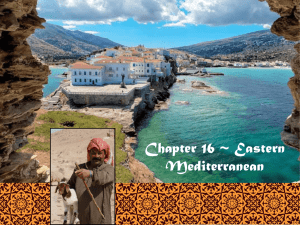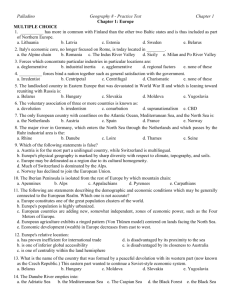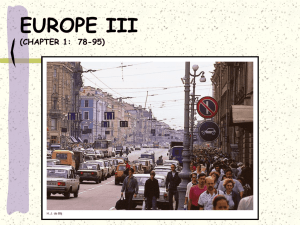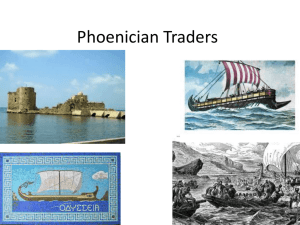People and Their Environment: the Eastern Mediterranean
advertisement
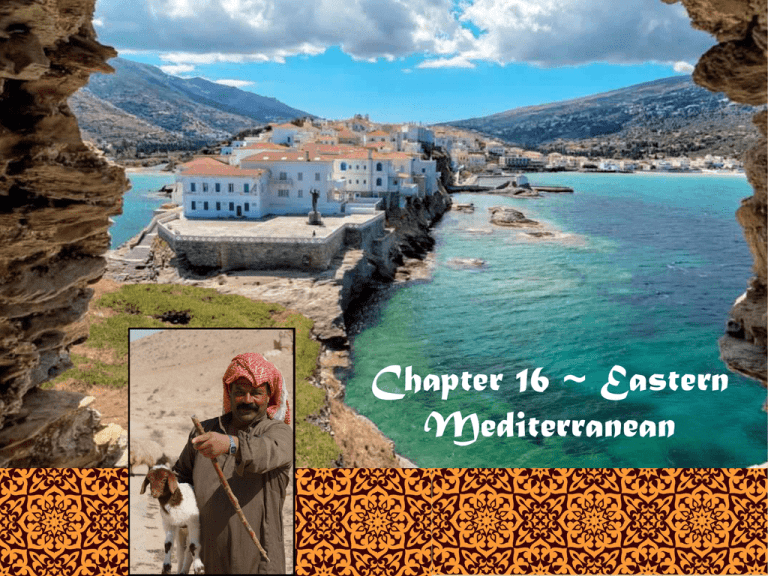
Chapter 16 ~ Eastern Mediterranean Physical Geography of the Eastern Mediterranean Landforms • This area is known as the Levant and includes Syria, Jordan, Lebanon, Israel, and the Palestinian territories. • The area is marked by mountains and deserts and has a generally temperate climate. • The sparsely populated Anti-Lebanon mountain range runs along the border between Syria and Lebanon. • The Syrian Desert is composed of gravel and used as a roadway. The Levant Anti-Lebanon Mountains form the majority of the border between Syria and Lebanon Syrian Desert v TURKEY SYRIA IRAQ JORDAN SAUDI ARABIA Physical Geography of the Eastern Mediterranean Water Systems • The Euphrates River is the most important river in Syria and provides the entire country with water. • Important for irrigation and agriculture, the Jordan River flows through all the countries in the subregion and provides a natural border between the West Bank and Jordan. • The Gulf of Aqaba connects the subregion with the Red Sea and Indian Ocean. Euphrates River – eastern Syria Jordan River Sinai Peninsula Gulf of Aqaba Physical Geography of the Eastern Mediterranean Climate, Biomes, & Resources • Rainfall is limited in the subregion, which consists of mostly semi-arid and arid climates. • The coastal regions have a Mediterranean climate that supports agriculture, and a wide array of vegetation and wildlife. • As one moves inland, the climate becomes humid subtropical, then shifts to semi-arid steppe and arid desert. • Lumber and minerals are important natural resources in the subregion. Question: What happens to the annual precipitation as you move East of the Mediterranean? Why does this happen? Human Geography of the Eastern Mediterranean Population Patterns • The dry, desert climate causes most people to live along the coastal plains. • Many ethnicities and religious sects reside in the subregion. • Demographics have changed drastically in the past century, with Israel experiencing a large migration of Russian Jews and the displacement of Palestinians following the establishment of the Israeli state. Human Geography of the Eastern Mediterranean Society & Culture Today • Arabic is the primary language in the subregion, with Hebrew also spoken in Israel. • Quality of education and health care varies widely from country to country. • Family life usually includes the extended family and often includes religious worship. • In Israel, women generally enjoy equal rights, while in Arabic countries, women’s rights vary greatly. Human Geography of the Eastern Mediterranean Economic Activities • Economic growth is dependent on agriculture, small deposits of minerals, and manufacturing. • Service industries play a significant role in the subregion’s economy, as does tourism, although it can be negatively affected by conflicts and political instability. • Water transportation is vital to the area, with the Strait of Tirān linking the Gulf of Aqaba to the Red Sea. Which country has the highest GDP per capita? Which has the lowest? People and Their Environment: the Eastern Mediterranean Managing Resources • Overfishing, contamination, a rise in sea surface temperatures, and the introduction of invasive species have caused environmental damage to the Mediterranean Sea. • High levels of urbanization and immigration have increased air pollution, which is exacerbated during heat waves. • Bird populations in the subregion also face a serious threat from illegal hunting. People and Their Environment: the Eastern Mediterranean Human Impact • Long-term deforestation and desertification, or the process in which arable land becomes desert, are two major problems in the subregion. • Large mammals have become endangered as a result of the destruction of their habitats. • Despite using desalination plants and water recycling programs, Israel will need to find new sources of fresh water as its agricultural sector grows. People and Their Environment: the Eastern Mediterranean Addressing the Issues • Legislation such as the Israeli Clean Air Law has attempted to address environmental issues. • International organizations have been trying to encourage governments to take environmental projects seriously and increase protective legislation. • More work is needed to help alleviate air and water pollution and to stop overfishing.
